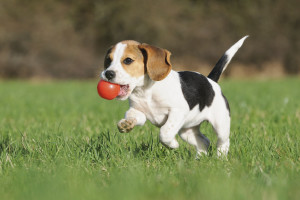Pets aren’t always easy to take care of, and they often require a substantial time commitment (something you’re all too aware of at, say, 3 a.m., when Bing Clawsby is finally ready to go outside and do his business). But pets provide an amazing return on that time investment, especially when it comes to your health. Case in point: According to the U.S. Centers for Disease Control and Prevention, pet owners tend to have lower blood pressure, cholesterol, and triglyceride levels than non-pet owners. But that’s not all. Pets also model many surprisingly healthy behaviors that humans would do well to emulate. Here are just a few, according to veterinarians, dog trainers, and other pet experts.
1. They focus on what matters most. You may get grumpy after a bad day at the office, but your pooch never does. “Companion animals mostly care about food, love, and shelter (not always in that order). As long as they have those things, they don’t need much else,” Mary Gardner, DVM, a veterinarian and cofounder of Lap of Love Veterinary Hospice tells Yahoo Health. “Pets also don’t complain much at all. People believe they hide their pain; I simply think they manage it differently.” If humans could model these behaviors, Gardner adds, we’d be healthier, happier, “and more people would want to be around us.”
2. They practice portion control (even if not by choice). Snowball might not want to limit her kibble intake any more than you want to limit your tortilla-chip intake. Nonetheless, she typically eats reasonably sized helpings of nutritionally balanced food — and never gets to eat straight out of the bag. Follow her lead. “Both animals and people need structure and regulation when it comes to portion size,” says Jme Thomas, executive director of Motley Zoo Animal Rescue based in Redmond, Washington.
3. They know how to de-stress. Your pooch doesn’t pour a glass of cabernet when the going gets rough (though, yes, it would make a very popular YouTube video if she did). She may, however, start begging for a walk or to play a game. Smart dog! “Actively seeking healthy activities — that function as de-stressors when stress levels are high — helps to reset people as well as dogs, and bring us back to a productive and functional status, from which many things feel a lot more ‘do-able,’” Marisa Scully, a certified dog behavior specialist in Philadelphia, tells Yahoo Health.
4. They hit the hay. People don’t get enough sleep: According to a 2014 survey by the National Sleep Foundation, 45 percent of Americans said that a lack of sleep had impaired their activities at least once in the previous week. Learn from your cat or dog, who knows just how important it is to get enough shut-eye, says Jeff Werber, VVM, president and chief veterinarian of Century Veterinary Group in Los Angeles. “Whether it’s a lazy dog day afternoon, or a quick cat nap, you won’t find them burning the candles at both ends.”
5. They stretch! There’s a reason one of the most common yoga moves is named downward dog. Dogs (and cats) stretch constantly — and we should do the same, notes certified dog behavior consultant Russell Hartstein. Why? Stretching can improve flexibility and reduce your risk of injury.
6. They’re open to new things. Animals are naturally curious. “Open a box or empty a bag and before you know it, your cat will have climbed in to investigate. Walk your dog past a gardener planting flowers and chances are she will check it out before moving on,” Werber says. “And they’re always up for some fun. A game of catch, a walk, a visit — bring it on.” Since research has found that seeking out new experiences can keep people feeling young and healthy, we’d do well to follow suit.
7. They’re comfortable getting zen. Numerous studies have found a correlation between mindful meditation and reduced stress, decreased heart disease, and a stronger immune response — and that’s something your cat already knows how to do instinctively. “Each morning I sit on the sofa with my cat, Turtle, while I drink my first cup of coffee,” says Kristen Levine, a pet living expert. “We spend about 10 minutes together, her getting neck and head rubs, me enjoying her purring and having a few meditative moments at the start of the day.It sounds simple, and it can be, but depending on the activity, it can have a powerfully relaxing or invigorating effect for both human and critter.”
Source: https://www.yahoo.com/health/7-health-lessons-our-pets-teach-us-112252958927.html




